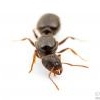Since I have a number of queens, and am terrible at actually keeping track of things, I will simply handle them all in one journal.
As of 6/18/2017, these are the queens, from top to bottom:
Queen Α: Tapinoma sessile
Captured about a week ago just crawling around. Her gaster doubled in size within a day, and she started laying within a day. I presently count 7 eggs, which are very tiny and difficult to capture with my phone. They are rather scattered, and I don't see her always tending to them. Not sure if she will do well long term.
Queen Δ: Camponotus chromaiodes
Captured last weekend (June 11, '17) in southern Illinois. Seems healthy, occasionally grooms herself and her gaster. No brood. Out of all of the queens, seems to dislike my presence the most. Quite pretty, though.
Queen Ε: Camponotus pennsylvanicus
Captured last Monday (June 12, '17). Was found under a rock next to a Tetramorium colony. Was either injured already, or was injured during capture - is missing her left antenna and part of her right front leg. Was given sugar water immediately after capture which she readily drank for about an hour - she practically doubled in size during this. She presently has a single egg which she laid yesterday (June 16, '17). She has been very consistent in tending to the egg - cleaning it regularly and randomly moving it around (but it always ends up back in the same spot anyways). Due to her injury, she does have some difficulty cleaning herself and moving efficiently.
Queen Ζ: Camponotus pennsylvanicus
Captured two days after Eta. Was found under a garbage can, and quickly captured. No brood, tends to lean on her side - not sure if actually healthy. Grooms regularly, including gaster. There does appear to be a very small dent in her gaster on the right side near the thorax, which from what I've read does not bode well for her. However, it doesn't guarantee failure - we'll see how she does.
Queen Η: Camponotus pennsylvanicus
First queen of the bunch captured, about three weeks ago. She landed next to me while I was working outside, and walked around for a bit, then scurried to hide under a tarp. I then captured her. No brood, has not removed wings. Her behavior is a bit different from the other queens - she doesn't groom as much, and sometimes 'investigates' the cotton plug but has not pulled on it. I suspect she cannot turn around in the tube due to her wings, which also means she cannot drink. I will likely move her into a larger (perhaps 20mm) tube on Monday. She does, however, have one of the largest gasters of them.
Queen Β: Tetramorium sp. cæspitum
Caught about a week ago. Was practically dead and being carried by a Tetramorium worker. I suspect she was captured and was to be used as food. I recovered her, gave her sugar water which she readily drank for some time, and doubled in size. She was the first queen to have any brood, but she is very poor about tending to them. Her brood are extremely scattered, and she seems to be addicted to the wet cotton - she doesn't leave it, and any new brood she has also attached to it, and she appears to be neglecting her old brood.
Queen Γ: Tapinoma sessile
Caught two days ago (June 15). Was just scurrying, same as the other. Since being put into a tube, has doubled in size, but I do not yet see any brood.















